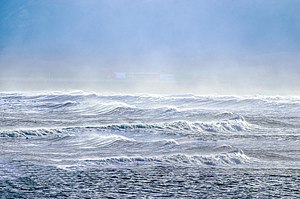
Back عوالق هوائية Arabic Luftplankton German Aeroplancton Spanish Aeroplankton Estonian Plancton aérien French Aeroplancton Italian 気生プランクトン Japanese Aeroplankton Polish Aeroplâncton Portuguese Аэропланктон Russian

| Part of a series on |
| Plankton |
|---|
 |
Aeroplankton (or aerial plankton) are tiny lifeforms that float and drift in the air, carried by wind. Most of the living things that make up aeroplankton are very small to microscopic in size, and many can be difficult to identify because of their tiny size. Scientists collect them for study in traps and sweep nets from aircraft, kites or balloons.[1] The study of the dispersion of these particles is called aerobiology.
Aeroplankton is made up mostly of microorganisms, including viruses, about 1,000 different species of bacteria, around 40,000 varieties of fungi, and hundreds of species of protists, algae, mosses, and liverworts that live some part of their life cycle as aeroplankton, often as spores, pollen, and wind-scattered seeds. Additionally, microorganisms are swept into the air from terrestrial dust storms, and an even larger amount of airborne marine microorganisms are propelled high into the atmosphere in sea spray. Aeroplankton deposits hundreds of millions of airborne viruses and tens of millions of bacteria every day on every square meter around the planet.
Small, drifting aeroplankton are found everywhere in the atmosphere, reaching concentration up to 106 microbial cells per cubic metre. Processes such as aerosolization and wind transport determine how the microorganisms are distributed in the atmosphere. Air mass circulation globally disperses vast numbers of the floating aerial organisms, which travel across and between continents, creating biogeographic patterns by surviving and settling in remote environments. As well as the colonization of pristine environments, the globetrotting behaviour of these organisms has human health consequences. Airborne microorganisms are also involved in cloud formation and precipitation, and play important roles in the formation of the phyllosphere, a vast terrestrial habitat involved in nutrient cycling.
- ^ A. C. Hardy and P. S. Milne (1938) Studies in the Distribution of Insects by Aerial Currents. Journal of Animal Ecology, 7(2):199-229